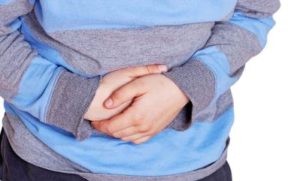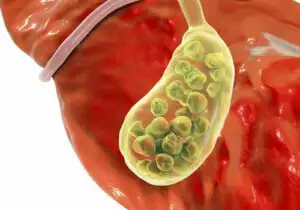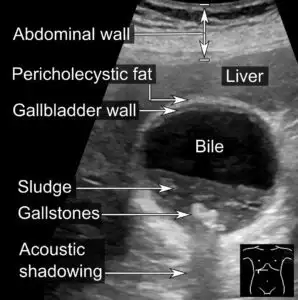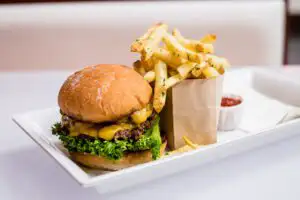
After attending a birthday party, 12-year-old Pragathi Khanna experienced intense abdominal pain. She was so uncomfortable that she couldn’t even leave her bed.
She started vomiting, which left her parents perplexed. They gave her various medicines, hoping to alleviate her discomfort, but when these measures proved ineffective, they rushed her to a private hospital.
At the hospital, the paediatrician ordered an ultrasound scan, which revealed a surprising diagnosis – gallstones.
Gallbladder stones no longer an adult issue?
Why is it surprising? Typically, gallbladder stones, or gallstones, are seen in adults, with approximately one in five adults developing them.
However, doctors claim that gallbladder stones are now becoming more prevalent among adolescents and teenagers, defying the assumption that they are solely an issue concerning older individuals.
Warning about the increase in the number of children developing gallstones, which leads to surgeries and removal of the gallbladder, Aster CMI Hospital’s Head of Paediatric Surgery, Dr Manjiri Somashekhar, tells South First, “A few decades or so ago, we used to hardly see gallbladder stones in children. But now, due to altered lifestyles, eating junk food, no exercise, added stress, high levels of cholesterol, and obesity, we are seeing children coming in with gallstones.”
Dog bites and rabies: Why even a scratch should be taken seriously
What are gallbladder stones?
Situated on the right side of the body, beneath the liver, the gallbladder is an organ responsible for storing bile. Bile is a digestive fluid produced by the liver.
During the process of food consumption, the gallbladder releases bile through connecting ducts that transport it to the intestines. In cases where the bile solidifies, it can result in the formation of gallstones.
 Gallbladder stones. (Getty Images)These stones can vary in size and composition, but they often consist of cholesterol or bilirubin.
Gallbladder stones. (Getty Images)These stones can vary in size and composition, but they often consist of cholesterol or bilirubin.
While there are many reasons why gallstones are formed in children, a high-fat diet or obesity plays a major role, says Dr Somashekhar.
She adds that young children, about 10-12 years old, are now weighing about 60-65 kg, which is not an ideal weight for that age at all.
“The BMI for this child was very high and with the kind of food they continue to eat, the ultra-processed food, the junk that goes into their body, and with almost zero exercise, it leads to altered metabolism. This can be one of the main reasons for formation of gallstones,” she explains.
Meanwhile, Dr Sivasankar Jayakumar, Consultant, Paediatric Surgery and Paediatric Urology at Prashanth Hospital in Chennai says, “While we are seeing some sort of increase in the number of children coming with gallstones, the exact cause of these gallbladder stones in children is not always clear, several factors can contribute to their formation.”
He adds, “Other than diet, environmental factors, and lifestyle, even blood disorders like sickle cell disease (where high amounts of bilirubin is produced, which can lead to formation of stones), genetic predisposition (a family history of gallbladder stones), Crohn’s disease, and so on, may also lead to gallstone formation. Though the prevalence is going up, I would still consider that the numbers are less compared to adults.”
Keto diet seen to improve PCOS symptoms in women, finds study
Ultrasound findings: Not always gallstones
While doctors warn parents not to be ignorant of gallstones and complaints from their children regarding repeated abdomen pains, nausea, or vomiting, they also add that it is important to know that not all ultrasound findings are gallstones.
 Gallbladder sludge and stones as seen in an ultrasound. (Wikimedia)Children can sometimes have gallbladder problems that look like stones but are not really stone formations. “These days, there are many things that an ultrasound scan pick up. It is able to diagnose a majority of the stones and asymptomatic stones, which is when we don’t have any symptoms of vomiting, fever, pain, etc. They would have come for a scan for some other reason and the stones tend to get picked up,” Dr Jayakumar explains.
Gallbladder sludge and stones as seen in an ultrasound. (Wikimedia)Children can sometimes have gallbladder problems that look like stones but are not really stone formations. “These days, there are many things that an ultrasound scan pick up. It is able to diagnose a majority of the stones and asymptomatic stones, which is when we don’t have any symptoms of vomiting, fever, pain, etc. They would have come for a scan for some other reason and the stones tend to get picked up,” Dr Jayakumar explains.
Explaining, he tells South First, “Many times, when an ultrasound scan show the presence of gallstones, it could actually be what is called gallbladder sludge, which is very common. This sludge is a thick, viscous mixture of bile components that can accumulate in the gallbladder.”
He adds, “It is primarily composed of cholesterol crystals, calcium salts, and other particles that can settle in the gallbladder when the balance of bile components is disrupted. This can happen sometimes when the child has not eaten well for a few hours due to common cold or other illnesses.”
This kind of sludge can go away after some time and such patients need not be treated for gallbladder stones.
However, he says, gallbladder sludge can sometimes lead to the formation of gallstones. “It is often considered a precursor to gallstone formation and may require medical attention or dietary changes to prevent further complications,” he adds.
Digene Gel recalled from market after DCGI cautioned against it
Symptoms of gallstones
Dr Jayakumar reiterates that not always do gallstones cause symptoms. Many times, they are asymptomatic. However, children with gallstones may complain of pain in the upper right or middle of the abdomen, just below the ribcage. The pain may be sharp, dull, or crampy, and can travel to the back or right shoulder.
“The pain may be worse after eating food high in fat. It can also lead to nausea or vomiting, fever, chills or sweats,” adds Dr Somashekhar.
A few blood tests, an ultrasound scan, a CT scan to check if there is inflammation or infection of the pancreas due to the gallstones are all key diagnostic and imaging tests required to detect any kind of disease in the gallbladder.
Prevention of gallstones
 Junk food is normally high in fats, sugars, and salt and is best avoided, say nutrition experts. (iStock)Dr Somashekhar says that many parents are ignorant about gallbladder stone formation, especially in children. She advises parents, right from a younger age, to take care of their child’s diet and set a discipline into their eating habits. Diets high in saturated fats and low in fibre may contribute to gallbladder stone development. Encouraging a balanced diet is crucial in preventing stones.
Junk food is normally high in fats, sugars, and salt and is best avoided, say nutrition experts. (iStock)Dr Somashekhar says that many parents are ignorant about gallbladder stone formation, especially in children. She advises parents, right from a younger age, to take care of their child’s diet and set a discipline into their eating habits. Diets high in saturated fats and low in fibre may contribute to gallbladder stone development. Encouraging a balanced diet is crucial in preventing stones.
She explains, “It is not possible to completely stop your child from eating junk. It is difficult. But setting a 80:20 ratio is better and this can then keep your child away from junk food most of the time. Gut health of the child is absolutely important and if they eat a lot of junk, there would be no immunity to even fight the altered gut.”
1 in 3 men most likely infected with HPV, says Lancet study
Identifying gallstones is important
Dr Jayakumar explains that once a child has been brought in for gallstones, it is important to first check and ascertain if it is indeed a gallstone and the reason behind its formation. For instance, is there any blood-related disorders that could have led to formation of the stone?
This can be checked through simple blood tests and scans. Once it is ascertained that it is a gallbladder stone, then the treatment options depend on the size of the stone and where it is located.
“If they come with mild symptoms of gallstones, then first, it is treated conservatively. We give them IV fluids, IV antibiotics, painkillers, and admit them for sometime. We don’t want to do any surgery when there is inflammation. Within 24 hours, we make an assessment whether the stone is in the gallbladder or is it stuck in bile duct.”
If it is in the gallbladder, then an elective surgery is opted for where either the stone is removed or the gallbladder itself is removed, says Dr Jayakumar.
So as far as treatment options go, a “wait and see” approach is first recommended to see if the stones are small, where they are located, if the condition is asymptomatic or mildly symptomatic. Meanwhile, encouraging a diet low in saturated fats and high in fibre can also prevent further stone formation if there is a gallbladder sludge.
Importance of Primary PTCA for myocardial infarction (heart attack)
Timely intervention is key
However, Dr Somashekhar says that if the stones are causing severe symptoms or complications, surgical removal of the gallbladder through laparoscopy is the best option.
She says that if it is ignored, the child might keep experiencing the same symptoms of pain, vomiting etc. The other issue is that the stones can pass into the common bile duct causing blockage, which can be very dangerous as it could lead to jaundice and other complications.
At this stage, removal of the stone also becomes very difficult, she adds.
Dr Somashekhar says that it can also lead to pus formation, leaving the child very sick and resulting in severe complications if there is no timely intervention.
Fortunately, the removal of the gallbladder is a minimally-invasive procedure and the absence of the organ requires very few changes to one’s diet and lifestyle.




 Driving Naari Programme launched in Chandigarh
Driving Naari Programme launched in Chandigarh






























